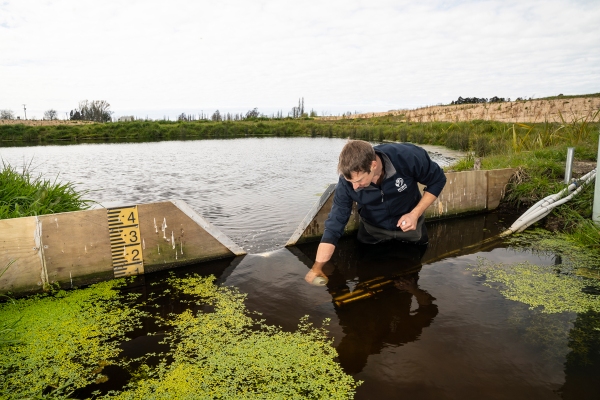The finishing touches have just been made on a NIWA-led project which aims to measure the performance of constructed wetlands on New Zealand farms.
A further three wetlands have been constructed, completing the suite of six new wetlands built on farms around the country as part of a four-year, $1.95 million project funded by the Ministry of Primary Industries.
Instrumentation has been installed to monitor performance of the wetlands, and analysis of flow and water quality data for the first year of operation of the existing three wetlands has been compiled and quality checked.
The project is led by a NIWA riparian and wetland scientist Brandon Goeller (Nelson) and principal scientist – aquatic pollution, Chris Tanner (Hamilton), supported by NIWA staff from around the country.
NIWA is working with five regional councils (Tasman, Taranaki, Hawke’s Bay, Bay of Plenty and Environment Canterbury) and landowners in each region to design constructed wetlands for each unique environment.
The regional councils have funded the construction of the wetlands and are co-funding and assisting with monitoring.
Water quality data gathered from the sites aims to demonstrate the ability of constructed wetlands to reduce losses of nutrients, suspended solids and faecal microbes from farmland to waterways.
DairyNZ and Beef+Lamb New Zealand are also partnering with NIWA and the councils to demonstrate the capability of wetlands to their members and networks.
The constructed wetlands receive a mixture of surface run-off, ground water and tile drainage from agricultural catchments.
A standardised monitoring programme has been set up for each wetland. Flows in and out of the wetland are continuously monitored.
Flow, turbidity and nitrate-N are continuously monitored in the inflow and outflow from the wetlands.
Grab water samples are collected from the inflow and outflow using automatic samplers over a range of flow conditions assessed for a wider range of contaminants.
Comparisons of water quality in inlet and outlet samples will help researchers quantify the performance of each wetland over 2-3 years.
Some of the constructed wetlands are at remote locations, so significant investment has been made in equipment for automated and telemetered sampling, alongside regular grab sampling by regional council staff.
Next steps involve calculating the mass loads of contaminants entering and leaving the wetlands.
Comparison of inflow and outflow loads over appropriate periods of time allows mass load reduction and attenuation rates for nitrogen, phosphorus, sediment and E.coli to be estimated.
Project researchers will work with councils to see how these data can be used in tools and models to manage nutrient losses from agricultural land to achieve improved water quality outcomes.
The lessons learned from building and managing the wetlands in different farming landscapes, will demonstrate to farmers what is involved with constructing wetlands and help improve practical guidelines and models to support their use to achieve water quality targets.
Useful links:


